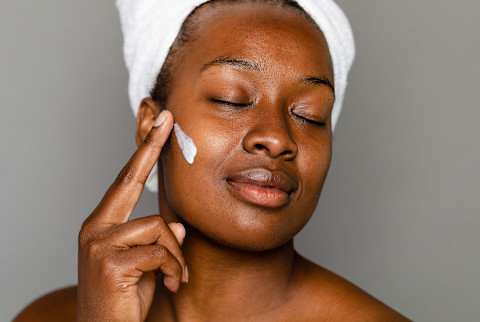Glucosamine Has Worked On The Skin Care Sidelines For Far Too Long

I try to refrain from calling any skin care ingredient "trendy" unless it's actually brand-new, but it's hard to ignore how popular players cycle through the spotlight. Niacinamide certainly received some buzz before allantoin captured our hearts—and who can forget when peptides hit the main stage?
Yet among all the hype, one ingredient has worked diligently on the sidelines for some time, collaborating with niacinamide, and allantoin, and peptides to power up their skin-smoothing benefits. And it's about time we give it its flowers!
Allow me to introduce you to glucosamine, the underrated skin care ingredient responsible for juicy complexions everywhere.
What is glucosamine?
Glucosamine is an amino sugar found naturally in your body, namely the skin and cartilage. It plays an important role in building cartilage and delaying its breakdown, but like most good things, it declines with age (big sigh).
This may sound familiar to another important family of proteins that support your joints and tissues—yep, collagen!—which makes sense, as the two are somewhat linked. Collagen is a structural component of our joints, whereas glucosamine (along with hyaluronic acid) is what helps them stay nicely lubricated.
And while we're on the topic of the beloved humectant: "Glucosamine is a precursor1 molecule to hyaluronic acid," board-certified dermatologist Brendan Camp, M.D., tells mindbodygreen. Meaning, it helps spur the natural production of hyaluronic acid in your body, which we know also diminishes with age.
Benefits for skin
Glucosamine is well known for its impact on joint health, but it has some noteworthy skin benefits too! After all, hyaluronic acid is the key molecule responsible for keeping skin naturally hydrated2, and its precursor molecule, glucosamine, is crucial.
It's hydrating
Similar to HA, "Glucosamine acts as a humectant, meaning that it helps attract and retain moisture in the skin," says Camp. Humectants, in case you need a refresher, help usher water into the top layer of your skin and hold it there, making the appearance plump and full of moisture.
Helps fill in fine lines
As your body's natural reserve of HA diminishes3, you may notice those physical signs of aging, like sagging and fine lines. By promoting your natural HA levels, you may relieve those etchings.
Fades dark spots
According to cosmetic chemist Ron Robinson, founder of BeautyStat, glucosamine can "help even out skin tone" due to its impact on melanin production. One randomized controlled trial4 found that applying a 2% glucosamine topical reduced the appearance of hyperpigmentation on the face, and when combined with 4% niacinamide, that effect on hyperpigmentation was even greater.
Gently exfoliates
Surprisingly, glucosamine also has the ability to balance keratinocytes (which make up 90% of skin cells) and make sure they don't become too sticky, which often leads to clogged pores. It's kind of like a mild AHA, in that it's gently exfoliating yet hydrating. One study5 even considers glucosamine a solid replacement for AHAs in skin care for those who experience irritation from acids.
Plays nicely with others
"Glucosamine may complement other skin care ingredients that offer hydration and skin-calming properties, like hyaluronic acid and niacinamide," notes Camp. Like the aforementioned dark spots study, which found a greater effect on hyperpigmentation by combining glucosamine and niacinamide.
It's such a universal crowd-pleaser and flies so well under the radar that it's probably in a bunch of ingredient lists you use already—check your labels for acetyl glucosamine or N-acetyl glucosamine.
Any side effects?
"It is generally well tolerated by all skin types, including those with sensitive skin," says Robinson. However, pure glucosamine comes from shellfish, Camp tells me, so those with shellfish allergies might want to steer clear.
Now, that being said, many skin care brands opt for vegan, synthetically derived forms of glucosamine, which should take those allergy concerns off the table. If you see N-acetyl glucosamine on the label, that's a good sign the brand uses the synthetic form, but I'd reach out to the brand to make sure if you have concerns.
How to use it
As I said, you probably have used glucosamine without even knowing it. It complements other hydrators well, which makes it a no-brainer for moisturizers, peptide serums, and skin-quenching masks. Additionally, given its ability to gently exfoliate and fade dark spots, you might find it in brightening formulas alongside other buzzy players like tranexamic acid and niacinamide.
Given that you have natural stores of glucosamine in your body, you can also go the ingestible route, if you choose. "Oral supplements of glucosamine are typically marketed for treatment of joints and arthritis-related symptoms," Camp says, while topicals are usually reserved for addressing signs of skin aging (fine lines, dark spots, etc.).
Still, glucosamine supplements do come with skin benefits. One study, in particular, found that eight weeks of taking glucosamine was associated with a positive effect on markers of skin aging, such as hyaluronic acid levels and collagen production. You could even double down with a quality hyaluronic acid supplement, which is associated with better skin aging6 and increased collagen production.
Again, if you have a shellfish allergy, you probably don't want to consume pure glucosamine, so synthetically derived topicals may be the way to go (with your health care professional's blessing, of course). Feel free to browse some stellar formulas below, best suited for those looking to treat fine lines, dark spots, and rough texture.
The takeaway
Think of glucosamine like hyaluronic acid's guardian. It's a precursor to the buzzy humectant, and you can't have one without the other. It's gentle, great for aging skin, and can be found in a number of topical formulas, as well as supplements. I'd say it earns main character status—don't you?
6 Sources
- https://pubmed.ncbi.nlm.nih.gov/17716251/#:~:text=Both%20glucosamine%20and%20its%20derivative,for%20the%20production%20of%20proteoglycans.
- https://www.ncbi.nlm.nih.gov/pmc/articles/PMC3583886/
- https://www.jaad.org/article/S0190-9622(16)00202-4/fulltext#:~:text=The%20skin's%20hyaluronic%20acid%20(HA,of%20fine%20lines%20and%20wrinkles.
- https://pubmed.ncbi.nlm.nih.gov/17348991/
- https://pubmed.ncbi.nlm.nih.gov/19691938/
- https://www.ncbi.nlm.nih.gov/pmc/articles/PMC5522662/




